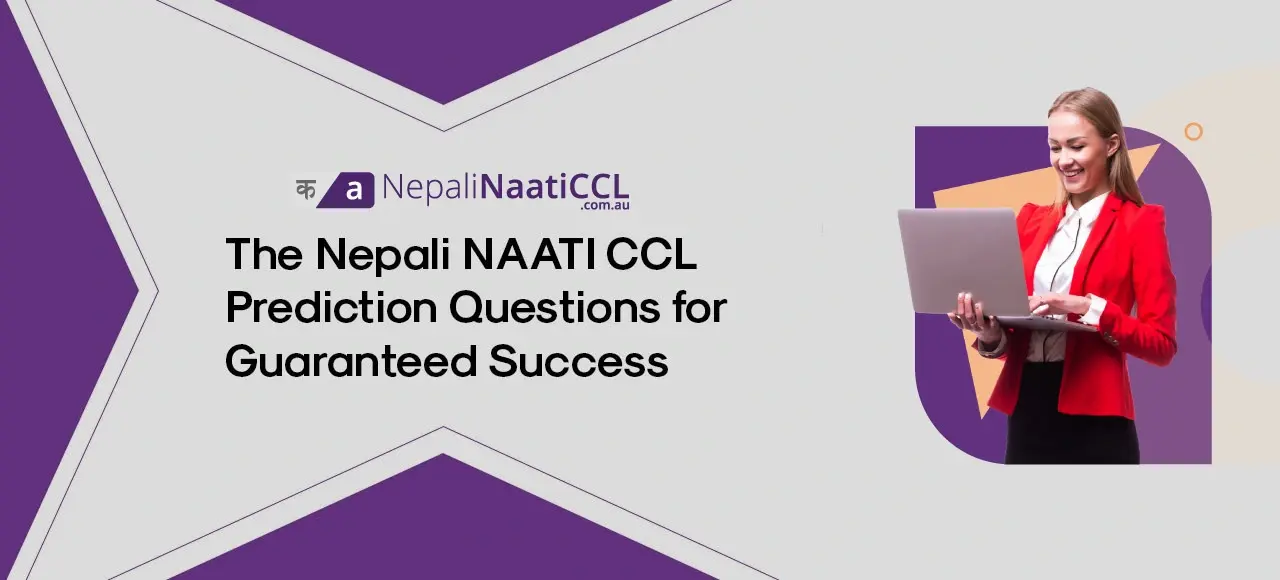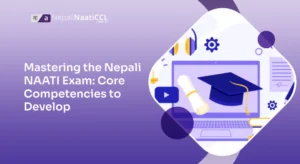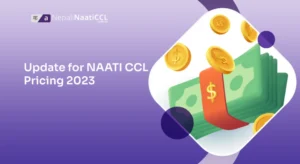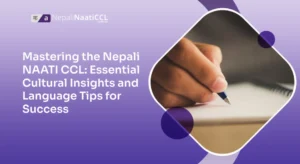Are you preparing for the Nepali NAATI CCL test and seeking a way to enhance your chances of success? Prediction questions are one of the smartest tools you can use. These are dialogue topics that frequently appear in the NAATI exam, giving you a real feel for what to expect.
In this guide, we’ll share the most common Nepali NAATI CCL prediction questions, explain why they matter, and show you how to practice effectively so you can walk into the test with confidence.
Why Focus on Prediction Questions?
The NAATI CCL (Credentialed Community Language) exam evaluates your ability to interpret conversations between English and Nepali. While the actual dialogues change every test cycle, some themes repeat.
- High Relevance: Topics such as healthcare, immigration, and education are always in demand.
- Time-Saver: Concentrating on repeated scenarios helps you prepare efficiently.
- Confidence Boost: Familiarity with likely situations reduces exam-day stress.
Most Common Nepali NAATI CCL Prediction Topics
Based on recent test-taker feedback and expert analysis, here are the top recurring themes:
1. Healthcare & Medical Visits
- Booking doctors’ appointments
- Describing symptoms and receiving medical advice
- Hospital admission or discharge conversations
2. Education & Childcare
- School enrolment procedures
- Parent–teacher meetings
- University admission counselling
3. Immigration & Government Services
- Applying for visas or PR points
- Discussing citizenship ceremonies
- Centrelink or social service appointments
4. Employment & Workplace
- Job interviews and salary negotiations
- Workplace health and safety discussions
5. Community & Legal Matters
- Reporting lost property
- Police station conversations
- Rental agreements and tenant rights
Sample Nepali NAATI CCL Prediction Questions
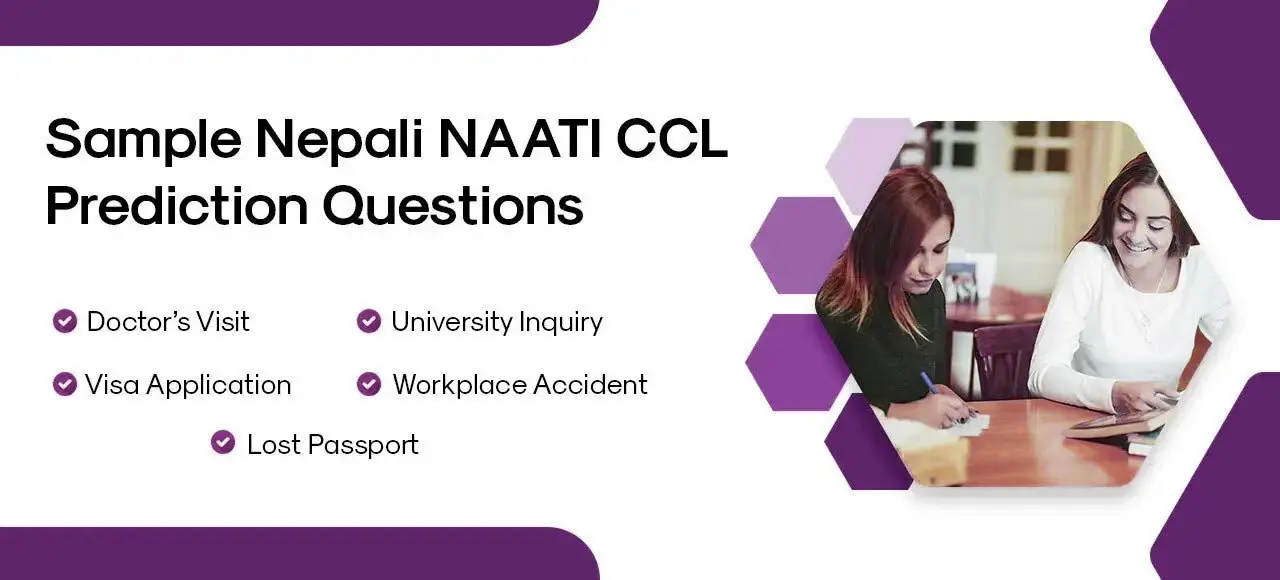
Below are expanded scenarios you can use for serious practice. Each one mirrors the style, length, and vocabulary you are likely to encounter in the actual Nepali NAATI CCL test.
Remember: You will need to interpret both English → Nepali and Nepali → English within a natural conversational flow.
1. Doctor’s Visit
Situation:
A concerned parent brings their five-year-old child to a general practitioner because the child has had a recurring fever for the last week.
Key Phrases to Prepare:
“Recurring fever,” “temperature spikes,” “antibiotics,” “follow-up appointment,” “blood test,” “hydration,” “rest.”
Practice Dialogue Outline:
- Parent explains the symptoms: duration, temperature, and medicines given.
- The doctor asks follow-up questions about appetite, coughing, or rash.
- The doctor advises a blood test, prescribes medication, and explains possible side effects.
- Parent asks about school attendance and when to return for a review.
2. University Inquiry
Situation:
A Nepali student is exploring postgraduate opportunities in Australia and visits the admissions office of a local university to learn about scholarships and application deadlines.
Key Phrases to Prepare:
“Application requirements,” “IELTS/PTE score,” “scholarship eligibility,” “tuition fees,” “course duration,” “official transcripts,” “visa conditions.”
Practice Dialogue Outline:
- Student introduces themselves and state their interest in a Master’s program.
- The admissions officer explains the required documents, deadlines, and fees.
- Discussion about scholarships, GPA requirements, and financial aid.
- Student asks about on-campus accommodation and orientation week.
3. Visa Application
Situation:
An applicant telephones the Department of Home Affairs to check the processing status of their partner visa.
Key Phrases to Prepare:
“Application reference number,” “processing times,” “biometric appointment,” “supporting documents,” “bridging visa,” “health examination,” “character check.”
Practice Dialogue Outline:
- Applicant provides name, date of birth, and application ID.
- Officer checks records and explains average processing timelines.
- Discussion of any missing documents or next steps.
- The officer provides guidance on travel restrictions while waiting.
4. Workplace Accident
Situation:
A factory supervisor reports a recent workplace injury to a WorkSafe inspector.
Key Phrases to Prepare:
“Incident report,” “safety procedures,” “first aid,” “protective equipment,” “investigation,” “workers’ compensation,” “follow-up inspection.”
Practice Dialogue Outline:
- The supervisor explains what happened, including the time and location.
- The inspector asks about safety training and emergency measures.
- Discussion of the injured employee’s condition and medical care.
- Inspector outlines next steps for an official safety audit.
5. Lost Passport
Situation:
A Nepali tourist reports a stolen passport at a local police station and requests an emergency travel document.
Key Phrases to Prepare:
“Lost property report,” “proof of identity,” “consular assistance,” “emergency certificate,” “travel itinerary,” “theft incident.”
Practice Dialogue Outline:
- The tourist describes when and where the passport was lost.
- Police officer takes details, including name, date of birth, and travel plans.
- The officer explains the process for a written report and how to contact the embassy.
- Discussion of temporary identification and safety tips.
Other Question Predictions for Nepali NAATI
1. Community – water restrictions, park cleanup/ renovation, gardening, pet adoption, animal shelter, electric bike road rules, volunteering, park clean up, neighbour issues, foster care, charity, flooding issues, school pickup, event organisation
2. Immigration/ Community – booking community hall, council-related, birthday celebration venue booking, family photoshoot, community centre
3. Education – Teacher-student feedback, class excursion, assignment feedback, Uni-professor and student assignment feedback, teacher-principal conversation, buying sports shoes for basketball, extracurricular activities, uniform buying, shoes buying, museum visit, teacher-parent conversation, exam result
4. Insurance – trauma insurance, health insurance, house insurance, personal item insurance
5. Business/ Employment – hiring a driver, store manager handling new staff/ handling customer complaints, bakers selling goods to the café, training, promotion, retail business issues, manager/ supervisor – employee conversation
6. Housing – house buying/ buying selling/ building inspection, house renovation, rental application
7. Business – web design, advertisement, selling artwork8. Consumer Affairs- item purchase/ return/ repair/ replacement (laptop repair, prescription glasses purchase
8. Health – Skin health, home care nursing, cold flu, home care, injury, GP appointment
9. Immigration – new migrant assistance
10. Social services – Aged care, disability support, allowance
11. Legal – Legal advice, neighbour dispute, compensation
How to Use These Scenarios for Maximum Benefit
- Time Yourself: Each NAATI CCL test contains two dialogues of about 300 words each. Try to complete both in real-time conditions, roughly 5–6 minutes per dialogue.
- Interpret Both Ways: Practice first English → Nepali, then Nepali → English, to build quick mental switching.
- Record and Review: Listen for hesitations, filler words, and pronunciation clarity.
Expert Tips to Maximise Your Practice
1. Record & Replay with a Critical Ear
-
- Use a smartphone or computer to record each session.
- Listen for pace, tone, and natural pauses. Check if your Nepali vocabulary matches the context (formal vs. informal).
- Identify problem areas, such as medical terminology or legal jargon and create a personal glossary.
2. Build a Professional Vocabulary Bank
-
- Collect domain-specific words: health, education, immigration, law, and community services.
- Make flashcards or use spaced-repetition apps (e.g., Anki) to memorise.
- Include both formal Nepali and natural conversational alternatives so you can adapt to any dialogue style.
3. Simulate the Exam Environment
-
- Sit in a quiet room with a timer set to the official test format.
- Add mild background noise (like a café sound) to train focus.
- Wear headphones to mimic the NAATI online testing conditions.
4. Seek Constructive Feedback
-
- Pair with another candidate or hire a tutor who understands the NAATI scoring criteria: accuracy, pronunciation, fluency, and register.
- Use professional platforms that provide AI scoring or human evaluation to track progress over time.
Resources for Nepali NAATI CCL Preparation
- Official NAATI Website
Visit naati.com.au for the latest test format, scheduling options, and official practice materials.
- Online Mock Test Platform
Several dedicated services (e.g., Nepali NAATI CCL mock test websites) provide timed practice with scoring feedback ideal for self-evaluation before the actual exam.
- Community & Peer Groups
Join Nepali-language NAATI preparation groups on Facebook, WhatsApp, or Telegram. Candidates often share newly reported prediction questions, vocabulary lists, and real-time exam experiences.
- Professional Coaching
Consider enrolling in a structured NAATI preparation course if you need intensive guidance on technique, vocabulary, and exam-day strategy.
Conclusion
Mastering the Nepali NAATI CCL exam isn’t just about language ability; it’s about strategic preparation.
By practising with these detailed prediction questions, timing your sessions, and applying expert techniques, you’ll build the fluency and confidence needed for a guaranteed pass and those crucial PR points for Australian immigration.
Frequently Asked Questions (FAQ)
1. What are Nepali NAATI CCL prediction questions?
Prediction questions are dialogue topics and scenarios that are repeatedly reported by recent test-takers. They represent the most common subjects, such as healthcare, immigration, education, and community services, likely to appear in the Nepali NAATI CCL exam.
2. Are prediction questions guaranteed to appear in the actual test?
No specific question is guaranteed, but prediction questions are based on patterns and recurring themes from previous exams. Practising them significantly increases your chance of encountering similar topics and builds confidence for any dialogue.
3. How many dialogue sets are in the Nepali NAATI CCL exam?
The test includes two dialogue sets, each approximately 300 words. Candidates must interpret conversations both from English to Nepali and from Nepali to English.
4. Why should I focus on prediction questions for exam preparation?
Because they:
- Save time by targeting high-frequency topics.
- Help you learn practical vocabulary and formal phrases.
- Reduce stress on exam day by making the scenarios feel familiar.
5. What are the most common prediction topics for the Nepali NAATI CCL?
The most repeated topics are:
- Healthcare & Medical Visits
- Education & Childcare
- Immigration & Visa Services
- Employment & Workplace Issues
- Community & Legal Matters
6. How should I practice these prediction questions?
- Record yourself interpreting both ways (English ↔ Nepali).
- Time each dialogue to match the real test (around 5–6 minutes).
- Review and note areas for improvement, such as grammar or pronunciation.
7. Can practising prediction questions help me gain PR points?
Yes. Passing the Nepali NAATI CCL exam awards 5 bonus points toward your Australian PR application. Focusing on prediction questions can increase your chances of passing on the first attempt.
8. Where can I find updated prediction questions?
You can find them by:
- Joining Nepali NAATI CCL preparation groups on Facebook or WhatsApp.
- Using professional coaching services or AI-based mock test platforms.
- Following recent candidates’ feedback and online forums that share current trends.
9. Do I need professional coaching to succeed?
Not necessarily. Many candidates pass through self-study and consistent practice with prediction questions. However, coaching or online mock tests can provide valuable feedback on accuracy, pronunciation, and timing.
10. How early should I start practising prediction questions?
Start at least 4–6 weeks before your test date. Begin with general vocabulary building, then focus on prediction questions during the final weeks for targeted preparation.
11. Can I rely only on prediction questions for guaranteed success?
While prediction questions are extremely helpful, it’s important to also practise a wide range of dialogues. NAATI may introduce new topics, so balanced preparation ensures you can handle unexpected situations.
12. Is there a difference between mock tests and prediction questions?
- Prediction Questions are topic suggestions based on trends.
- Mock Tests are full practice exams that simulate real conditions.
Using both together provides the strongest preparation.



